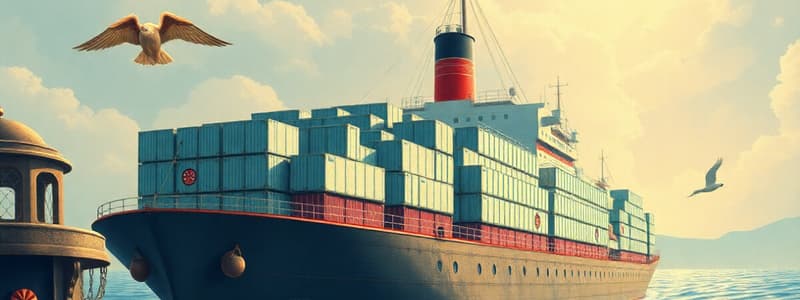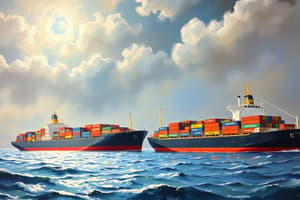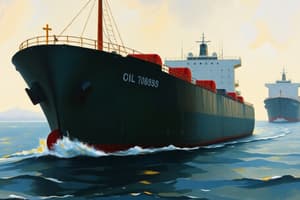Podcast
Questions and Answers
What is the primary function of a bulk carrier according to international definitions?
What is the primary function of a bulk carrier according to international definitions?
- To carry dry cargo in bulk without packaging. (correct)
- To transport liquid goods in standardized containers.
- To serve solely as a fishing vessel with refrigerated holds.
- To carry packaged cargo using multiple decks.
What are common safety problems associated with bulk carriers?
What are common safety problems associated with bulk carriers?
- Corrosion of onboard computers and navigation systems.
- Inadequate crew size to operate the vessel.
- Excessive wind resistance during navigation.
- Cargo shifting and spontaneous combustion. (correct)
What percentage of the world's merchant fleets do bulk carriers comprise?
What percentage of the world's merchant fleets do bulk carriers comprise?
- 15 percent
- 30 percent
- 25 percent
- 21 percent (correct)
Which of the following features characterizes geared bulk carriers?
Which of the following features characterizes geared bulk carriers?
What has been linked to increased sinkings of bulk carriers in the 1990s?
What has been linked to increased sinkings of bulk carriers in the 1990s?
Which of the following is NOT a subclass of bulk carriers?
Which of the following is NOT a subclass of bulk carriers?
What is one purpose of the large hatchways on bulk carriers?
What is one purpose of the large hatchways on bulk carriers?
Which country is noted as the largest single builder of bulk carriers?
Which country is noted as the largest single builder of bulk carriers?
What is the maximum deadweight tonnage (DWT) that a bulk carrier can carry based on the content provided?
What is the maximum deadweight tonnage (DWT) that a bulk carrier can carry based on the content provided?
How do geared bulk carriers differ from gearless bulk carriers?
How do geared bulk carriers differ from gearless bulk carriers?
What is a primary factor contributing to bulk cargo saturation?
What is a primary factor contributing to bulk cargo saturation?
What unique capability do some specialized designs of bulk carriers possess?
What unique capability do some specialized designs of bulk carriers possess?
What role do crews of bulk carriers play in the operation of the vessel?
What role do crews of bulk carriers play in the operation of the vessel?
Which of the following statements about bulk carriers is true?
Which of the following statements about bulk carriers is true?
What type of engine is commonly used in bulk carriers?
What type of engine is commonly used in bulk carriers?
When was the first specialized bulk carrier built?
When was the first specialized bulk carrier built?
What primary distinction is made between bulk carriers?
What primary distinction is made between bulk carriers?
What does the abbreviation 'OBO' stand for in the context of bulk carriers?
What does the abbreviation 'OBO' stand for in the context of bulk carriers?
Which of the following historical methods was NOT used to move bulk goods by ship before the development of specialized bulk carriers?
Which of the following historical methods was NOT used to move bulk goods by ship before the development of specialized bulk carriers?
Which of these ships is recognized as the first steam-powered bulk carrier?
Which of these ships is recognized as the first steam-powered bulk carrier?
What innovation did the collier John Bowes introduce to the bulk shipping industry?
What innovation did the collier John Bowes introduce to the bulk shipping industry?
What is indicated by the terms 'VLOC' and 'ULOC' in bulk carrier designations?
What is indicated by the terms 'VLOC' and 'ULOC' in bulk carrier designations?
Why did the efficiency of loading and unloading influence the design of bulk carriers?
Why did the efficiency of loading and unloading influence the design of bulk carriers?
What was a challenge faced by shippers prior to the advent of specialized bulk carriers?
What was a challenge faced by shippers prior to the advent of specialized bulk carriers?
What architectural concern is primarily associated with the design of bulk carriers?
What architectural concern is primarily associated with the design of bulk carriers?
What is the purpose of a naval architect's calculations regarding scantlings?
What is the purpose of a naval architect's calculations regarding scantlings?
Which of the following has been adopted to ensure safety in bulk carriers since April 2006?
Which of the following has been adopted to ensure safety in bulk carriers since April 2006?
What significant structural issue arises from cargo shifting in bulk carriers?
What significant structural issue arises from cargo shifting in bulk carriers?
Which of the following stresses is specifically mentioned as requiring careful study in bulk carrier design?
Which of the following stresses is specifically mentioned as requiring careful study in bulk carrier design?
What caused a series of international safety resolutions for bulk carriers to be adopted in the 1990s?
What caused a series of international safety resolutions for bulk carriers to be adopted in the 1990s?
What role do scantlings play in the construction of a bulk carrier?
What role do scantlings play in the construction of a bulk carrier?
Between 1990 and 1997, how many bulk carriers were reportedly lost?
Between 1990 and 1997, how many bulk carriers were reportedly lost?
Which organization is primarily concerned with the safety of bulk carriers?
Which organization is primarily concerned with the safety of bulk carriers?
What does the document titled 'Bulk Cargoes: A Guide to Good Practice' primarily address?
What does the document titled 'Bulk Cargoes: A Guide to Good Practice' primarily address?
Which publication contains ISBN information for manuals related to maritime practices?
Which publication contains ISBN information for manuals related to maritime practices?
What type of accidents does the Marine Accident Investigation Branch investigate according to the document?
What type of accidents does the Marine Accident Investigation Branch investigate according to the document?
Which title focuses on the stability and trim related to the duties of a ship's officer?
Which title focuses on the stability and trim related to the duties of a ship's officer?
Which document summarizes recommendations concerning bulk carrier safety from a maritime committee?
Which document summarizes recommendations concerning bulk carrier safety from a maritime committee?
What is a potential focus area covered in the 'Maritime Safety Committee's 71st Session' report?
What is a potential focus area covered in the 'Maritime Safety Committee's 71st Session' report?
Which of these references provides a historical perspective on maritime safety practices?
Which of these references provides a historical perspective on maritime safety practices?
What is the core function of Oshima Hy-Con bulk carriers?
What is the core function of Oshima Hy-Con bulk carriers?
Which feature distinguishes the 'Ultra Handymax' bulk carrier from other types?
Which feature distinguishes the 'Ultra Handymax' bulk carrier from other types?
What was the main focus of the Oil Pollution Act of 1990 regarding double-hull tankers?
What was the main focus of the Oil Pollution Act of 1990 regarding double-hull tankers?
As per research, what are double-skin bulk carriers perceived to be?
As per research, what are double-skin bulk carriers perceived to be?
What does the International Maritime Organization focus on regarding bulk carriers?
What does the International Maritime Organization focus on regarding bulk carriers?
Prior to 2007, what was the status of formal safety assessments for bulk carriers?
Prior to 2007, what was the status of formal safety assessments for bulk carriers?
What is one of the major challenges regarding the structural rules for bulk carriers?
What is one of the major challenges regarding the structural rules for bulk carriers?
What is the primary function of the document 'Notes on Cargo Work' by John F. Kemp?
What is the primary function of the document 'Notes on Cargo Work' by John F. Kemp?
Flashcards
Bulk Carrier
Bulk Carrier
A merchant ship designed to transport unpackaged bulk cargo like grain, coal, ore, or steel. They are specialized to maximize capacity, safety, efficiency, and durability.
Handymax
Handymax
A subclass of bulk carriers typically smaller than Panamax ships. They can navigate through the Panama Canal.
Panamax
Panamax
A subclass of bulk carriers that can fit through the Panama Canal.
Capesize
Capesize
Signup and view all the flashcards
Capesize
Capesize
Signup and view all the flashcards
Deadweight Tonnage (DWT)
Deadweight Tonnage (DWT)
Signup and view all the flashcards
Chinamax
Chinamax
Signup and view all the flashcards
What is a bulk carrier?
What is a bulk carrier?
Signup and view all the flashcards
Geared vs. Gearless Bulk Carrier
Geared vs. Gearless Bulk Carrier
Signup and view all the flashcards
Safety Risks with Bulk Cargo
Safety Risks with Bulk Cargo
Signup and view all the flashcards
Large Hatchways: Pros and Cons
Large Hatchways: Pros and Cons
Signup and view all the flashcards
SOLAS Definition of a Bulk Carrier
SOLAS Definition of a Bulk Carrier
Signup and view all the flashcards
Bulk Carrier Sinkings in the 1990s
Bulk Carrier Sinkings in the 1990s
Signup and view all the flashcards
Improvements in Bulk Carrier Safety
Improvements in Bulk Carrier Safety
Signup and view all the flashcards
Responsibilities of a Bulk Carrier Crew
Responsibilities of a Bulk Carrier Crew
Signup and view all the flashcards
Dry Bulk Carrier
Dry Bulk Carrier
Signup and view all the flashcards
OBO (Ore-Bulk-Oil)
OBO (Ore-Bulk-Oil)
Signup and view all the flashcards
O/O (Oil/Ore)
O/O (Oil/Ore)
Signup and view all the flashcards
VLBC (Very Large Bulk Carrier)
VLBC (Very Large Bulk Carrier)
Signup and view all the flashcards
ULBC (Ultra-Large Bulk Carrier)
ULBC (Ultra-Large Bulk Carrier)
Signup and view all the flashcards
Small Bulk Carrier
Small Bulk Carrier
Signup and view all the flashcards
Early Bulk Shipping Methods - Sacking & Palletizing
Early Bulk Shipping Methods - Sacking & Palletizing
Signup and view all the flashcards
Scantlings
Scantlings
Signup and view all the flashcards
Springing
Springing
Signup and view all the flashcards
Double Hulls
Double Hulls
Signup and view all the flashcards
Stress Analysis
Stress Analysis
Signup and view all the flashcards
Stability
Stability
Signup and view all the flashcards
Cargo Shifting
Cargo Shifting
Signup and view all the flashcards
Common Structural Rules
Common Structural Rules
Signup and view all the flashcards
What is a Chinamax?
What is a Chinamax?
Signup and view all the flashcards
What is a Handymax?
What is a Handymax?
Signup and view all the flashcards
What is a double-hulled bulk carrier?
What is a double-hulled bulk carrier?
Signup and view all the flashcards
What is a double-skin bulk carrier?
What is a double-skin bulk carrier?
Signup and view all the flashcards
What is Deadweight Tonnage (DWT)?
What is Deadweight Tonnage (DWT)?
Signup and view all the flashcards
What is a Capesize?
What is a Capesize?
Signup and view all the flashcards
What is a Panamax?
What is a Panamax?
Signup and view all the flashcards
What are Capesize Bulk Carriers?
What are Capesize Bulk Carriers?
Signup and view all the flashcards
What are Panamax Bulk Carriers?
What are Panamax Bulk Carriers?
Signup and view all the flashcards
What are Chinamax Bulk Carriers?
What are Chinamax Bulk Carriers?
Signup and view all the flashcards
What is the difference between Geared and Gearless Bulk Carriers?
What is the difference between Geared and Gearless Bulk Carriers?
Signup and view all the flashcards
What are some safety risks associated with Bulk Carriers?
What are some safety risks associated with Bulk Carriers?
Signup and view all the flashcards
What are the pros and cons of large hatchways on Bulk Carriers?
What are the pros and cons of large hatchways on Bulk Carriers?
Signup and view all the flashcards
How does SOLAS define a Bulk Carrier?
How does SOLAS define a Bulk Carrier?
Signup and view all the flashcards
Study Notes
Bulk Carriers
- A bulk carrier is a merchant vessel designed for transporting unpackaged bulk cargo, like grain, coal, ore, steel coils, or cement.
- They've increased in size and sophistication since 1852, driven by economic factors.
- Bulk carriers currently account for 21% of the world's merchant fleet.
- Sizes range from mini-bulk carriers with a single hold to massive ore carriers carrying up to 400,000 metric tons.
- Some are self-unloading, some rely on port facilities, and some package cargo during loading.
- Greek, Japanese, and Chinese owners comprise a large portion of the bulk carrier fleet.
- South Korea is the leading builder of these ships, with 82% built in Asia.
- Crews manage operations, safety, navigation, and cargo handling, following international maritime regulations.
- Cargo loading and unloading can take days, depending on the complexity and port facilities.
Subclasses
- Handymax, Handysize, Panamax, Capesize, and Chinamax are different sizes of bulk carriers.
- Over 12,700 vessels over 500 GT were active.
General Characteristics (Typical)
- Up to 400,000 DWT
- 300 meters in length
- 40 meters in height
- 2-stroke diesel engine and 1 propeller
- 12 knots speed
Cargo Concerns
- Dense, corrosive, or abrasive bulk cargo presents potential dangers like shifting, combustion, or saturation.
- Large hatchways can exacerbate flooding risks.
- Old ships with corrosion issues pose additional safety concerns.
Studying That Suits You
Use AI to generate personalized quizzes and flashcards to suit your learning preferences.




